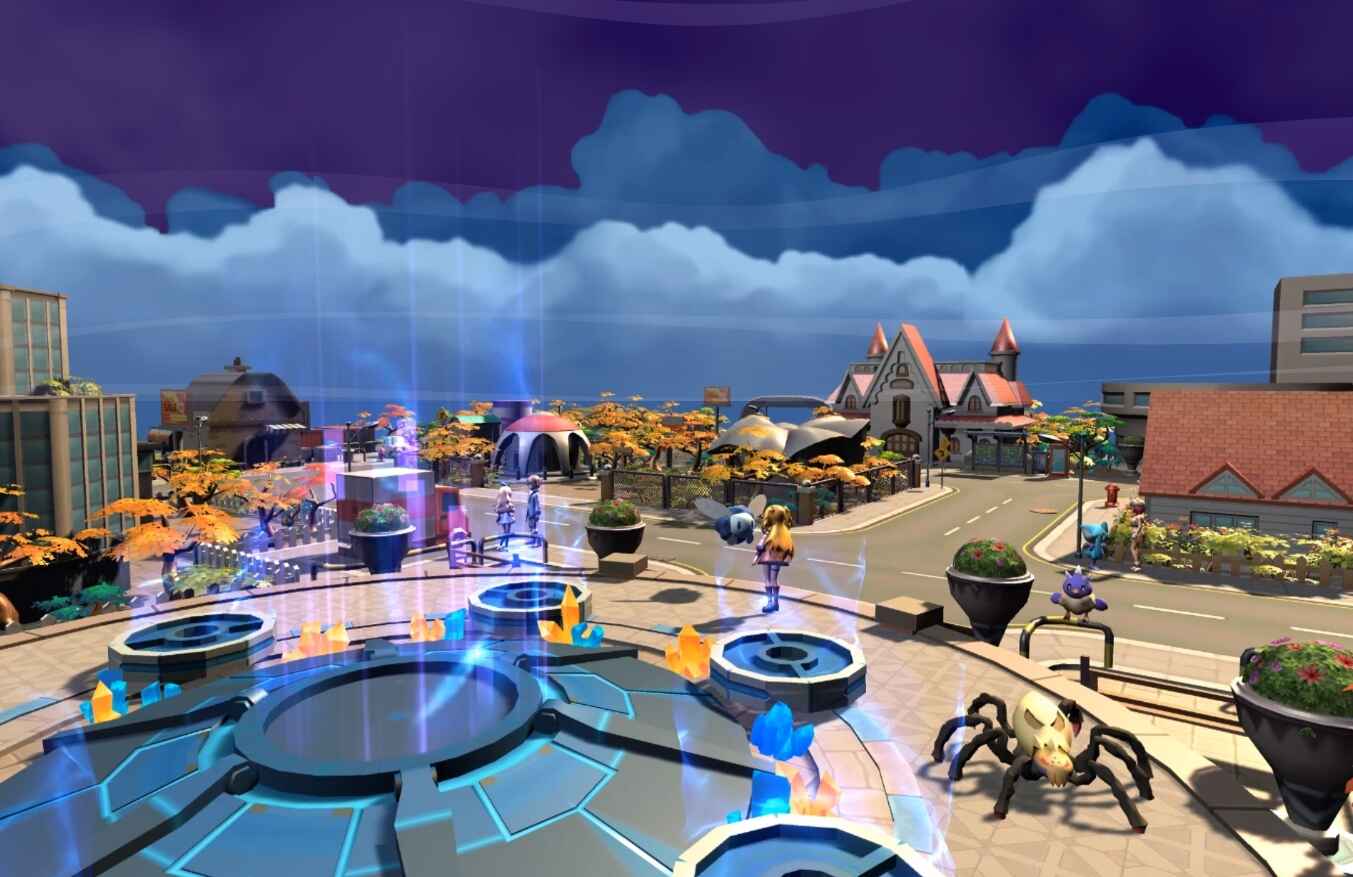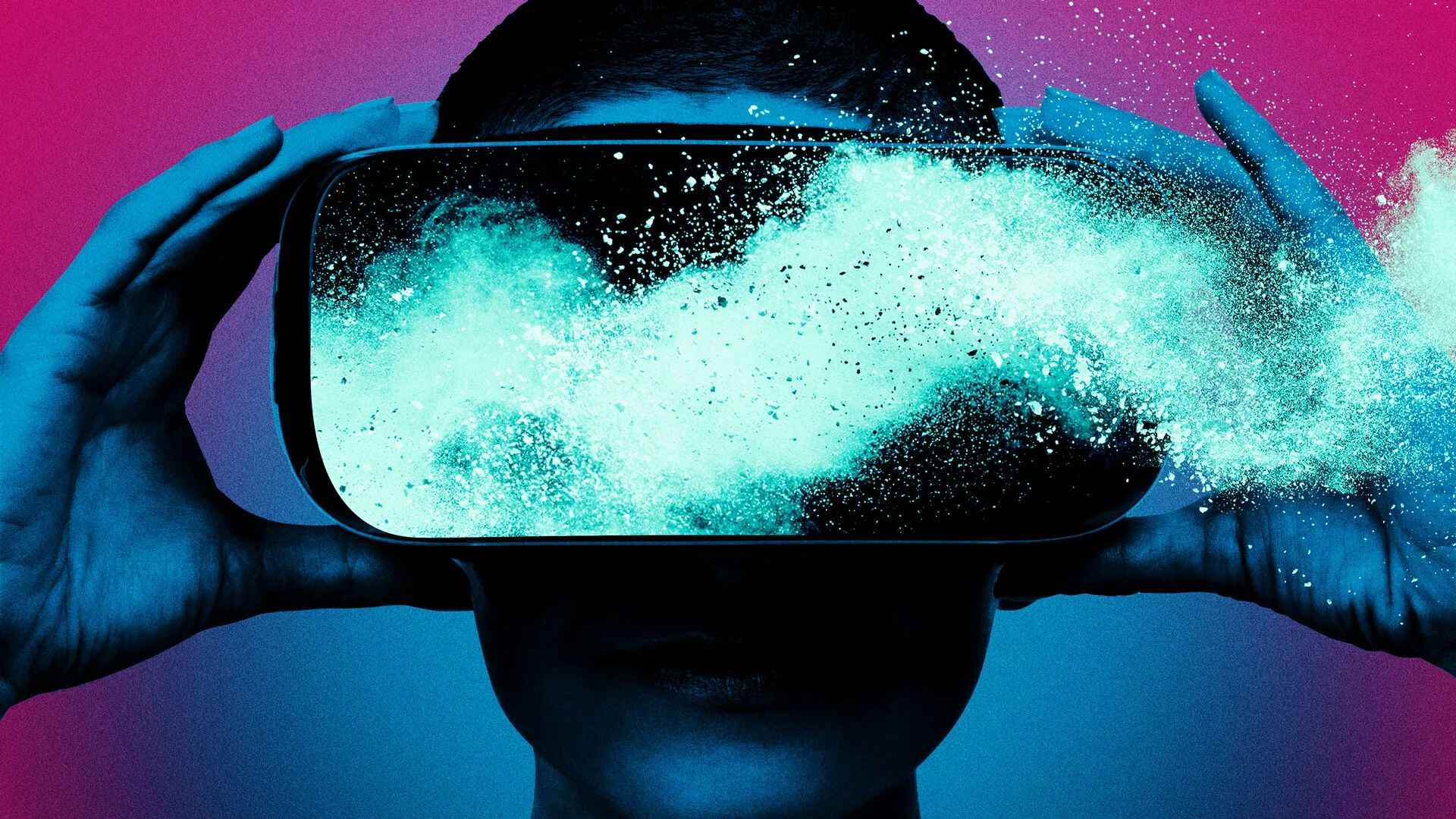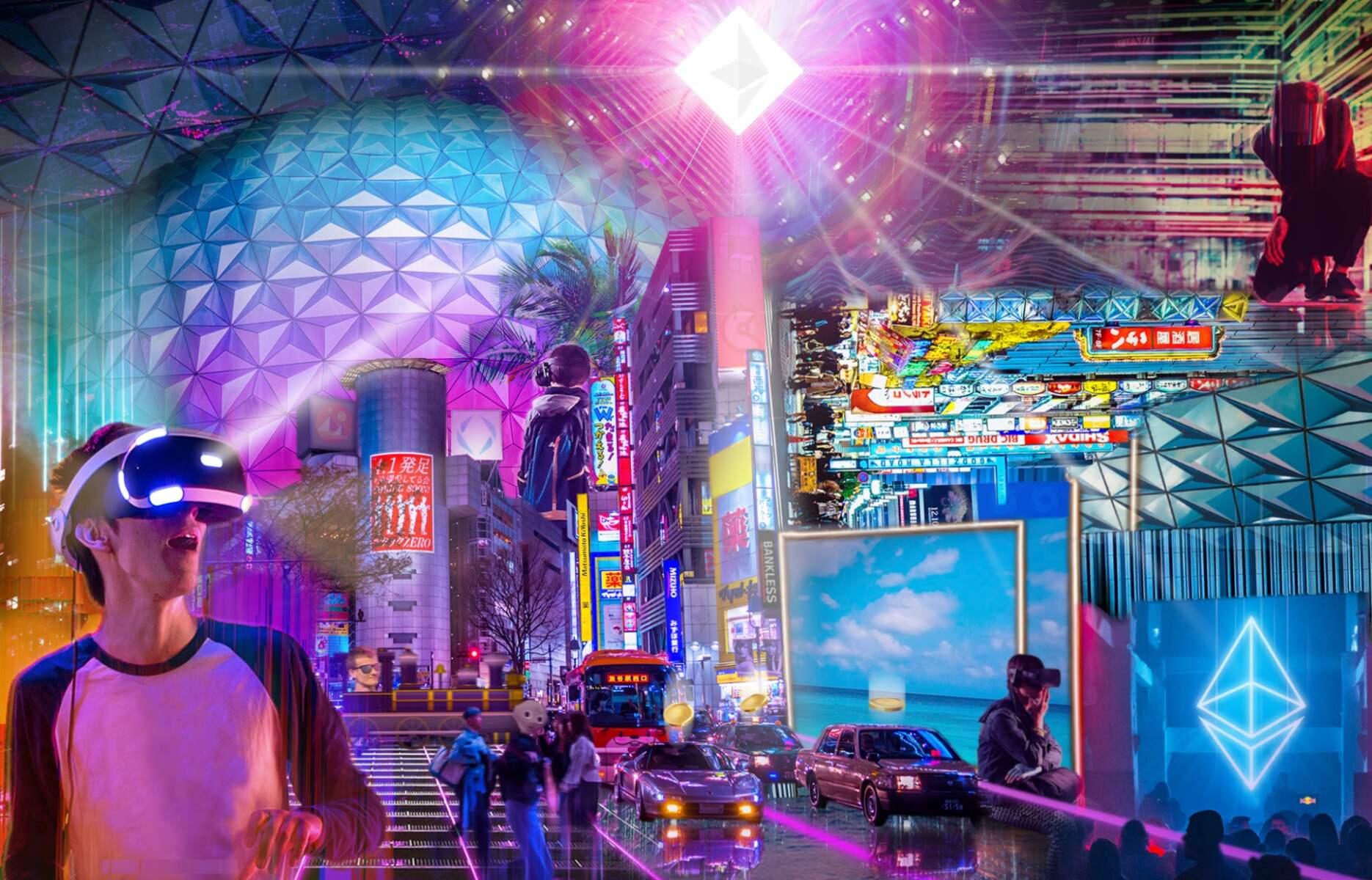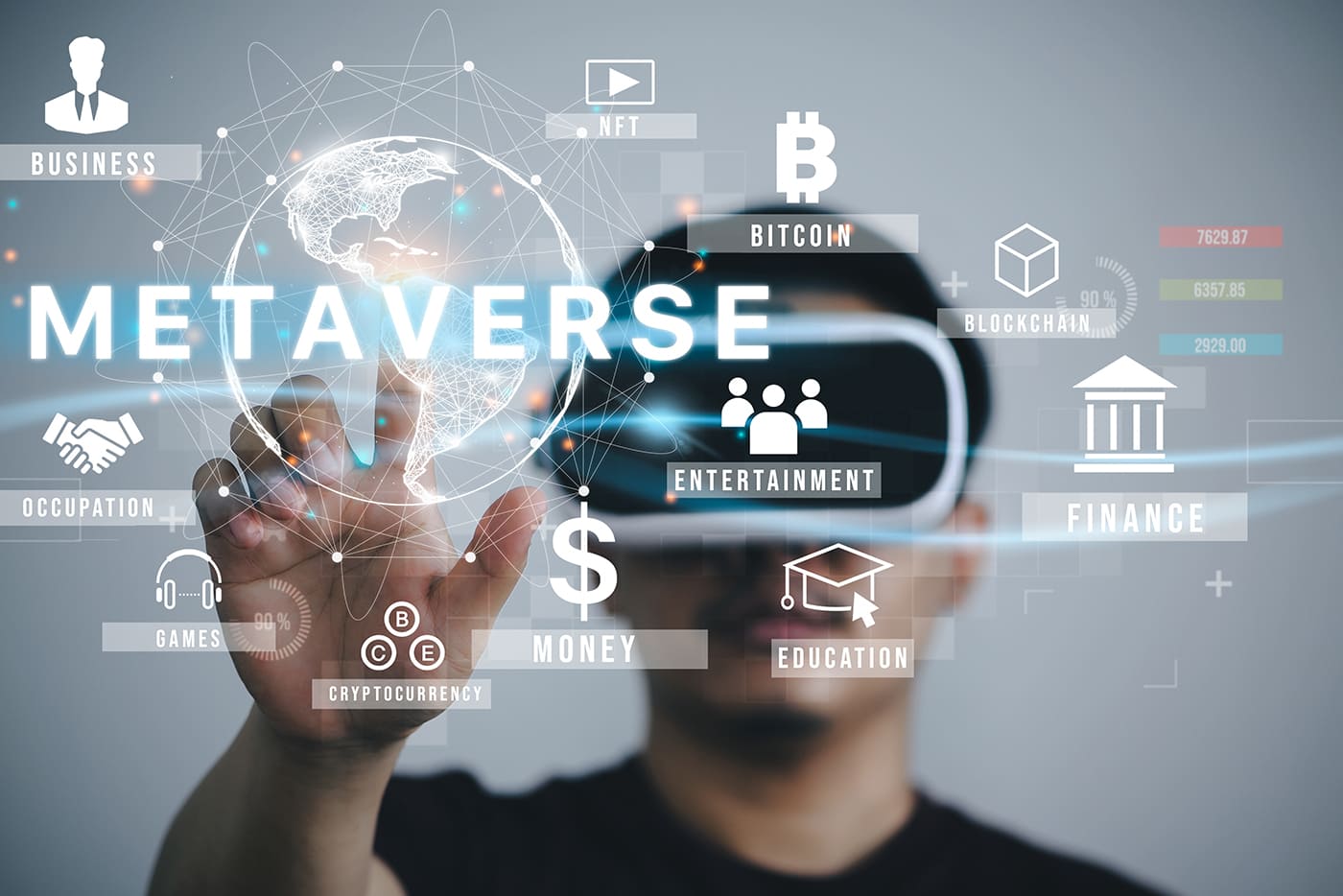What is the Metaverse?
The term “Metaverse” has gained significant attention lately, but what exactly does it mean? Put simply, the Metaverse refers to a virtual reality space where users can engage with a variety of digital experiences and interact with others in a simulated environment. It is a convergence of augmented reality (AR), virtual reality (VR), and the internet, creating a fully immersive and interactive online world.
In the Metaverse, users can explore virtual landscapes, interact with digital objects, and connect with other participants in real-time. Think of it as a parallel digital universe that exists alongside the physical world, but with infinite possibilities and no physical limitations.
The concept of the Metaverse was popularized by science fiction, with Neal Stephenson’s novel “Snow Crash” being one of the earliest mentions. However, with recent advancements in technology and the growing popularity of VR and AR devices, the idea of a fully realized Metaverse is becoming more tangible.
At its core, the Metaverse is about creating a shared space where individuals can escape the limitations of the physical world and experience new forms of expression, interaction, and collaboration. It offers a platform for people to interact, socialize, and engage in various activities – from gaming and entertainment to commerce and education.
One of the key features of the Metaverse is its immersive nature. By using VR headsets, haptic feedback devices, and other advanced technologies, users can feel like they are truly present in the virtual environment. This heightened sense of presence fosters a more immersive and engaging experience, blurring the lines between the physical and digital realms.
The Metaverse is not limited to a single platform or application. It encompasses a multitude of interconnected virtual worlds, each offering unique experiences and opportunities. From massive multiplayer online games (MMOs) to virtual marketplaces and social platforms, the Metaverse is an interconnected ecosystem where users can seamlessly navigate between different spaces and engage in a wide range of activities.
In summary, the Metaverse is a virtual reality space where people can immerse themselves in a digital world, interact with others, and explore limitless possibilities. It represents a shift towards a more interconnected, immersive, and interactive online experience, offering new avenues for creativity, socialization, and personal growth.
The Concept of the Metaverse
The Metaverse is not just a mere extension of virtual reality or augmented reality. It represents a new concept of a fully interconnected and immersive digital world, where users can seamlessly interact and engage in a wide variety of activities. The term “Metaverse” is derived from the combination of the words “meta,” meaning beyond, and “universe,” indicating a vast and limitless space.
The Metaverse is often described as a collective virtual reality space, encompassing various virtual worlds and digital experiences. It goes beyond the boundaries of a single game or platform, offering a cohesive and interconnected online environment. Users can explore different virtual landscapes, engage with virtual objects and characters, and interact with other participants in real-time.
What sets the Metaverse apart from other virtual reality experiences is its scale and complexity. It aims to create a fully immersive and interactive digital universe where the laws of physics can be altered, and imagination knows no bounds. It is not limited to individual games or experiences but rather encompasses an entire ecosystem of interconnected virtual spaces, each with its own unique features and opportunities.
In the Metaverse, users have the freedom to create, own, and customize their digital identities. They can shape their avatars to reflect their real-life appearance or delve into fantasy and create entirely new personas. This concept of virtual identity blurs the lines between the physical and digital realms, allowing users to express themselves in ways that were previously unimaginable.
Furthermore, the Metaverse is not confined to entertainment and gaming. It has the potential to revolutionize multiple industries, including education, healthcare, commerce, and social interactions. Imagine attending virtual classrooms, collaborating on projects with people from different parts of the world, or using virtual reality to simulate medical procedures for training purposes. The possibilities are endless.
Another key aspect of the Metaverse is its collaborative nature. Users can join forces with others to explore virtual worlds, tackle challenges, and create new experiences together. Whether it’s teaming up in virtual games or collaborating on virtual art projects, the Metaverse encourages socialization and cooperation, transcending geographical barriers and fostering a sense of global community.
In summary, the concept of the Metaverse goes beyond traditional virtual reality or augmented reality. It represents a interconnected and immersive digital universe, where users can explore, interact, and create in a limitless virtual landscape. It is a space where individuals can transcend physical boundaries, unleash their creativity, and engage with others in real-time. The Metaverse is not just a technology; it is a new way of experiencing and shaping our digital future.
The Evolution of the Metaverse
The concept of the Metaverse has been evolving over the years, thanks to advancements in technology and the increasing demand for immersive digital experiences. It has come a long way from its early roots in science fiction to the emerging reality we see today.
The idea of a virtual reality space where users could interact and explore began to surface in the 1990s. It was during this time that the internet became more accessible, and computer graphics capabilities improved. Early virtual reality systems like the Sega VR and Virtuality arcade machines served as glimpses into the possibilities of immersive digital experiences.
However, it was not until the 2010s that the Metaverse truly started to take shape. The development of powerful VR headsets like the Oculus Rift and HTC Vive, along with advancements in graphics processing and networking technologies, paved the way for more realistic and interactive virtual environments.
The gaming industry played a significant role in driving the evolution of the Metaverse. Massively multiplayer online games (MMOs) like World of Warcraft and Second Life demonstrated the potential of creating vast and immersive virtual worlds with millions of users interacting simultaneously. These games offered a taste of what the Metaverse could become, attracting a dedicated user base and fostering virtual economies within their virtual realms.
In recent years, the rise of blockchain technology and cryptocurrencies has further fueled the growth of the Metaverse. Blockchain provides a decentralized infrastructure that enables true ownership and control of digital assets, paving the way for the creation and trading of virtual goods and currencies within virtual worlds. This has opened up new possibilities for economic systems and entrepreneurship within the Metaverse.
Moreover, advancements in augmented reality (AR) have also contributed to the evolution of the Metaverse. With the widespread adoption of smartphones and AR-enabled devices, users can now overlay digital content onto the real world, blurring the boundaries between the physical and virtual realms. AR applications like Pokémon Go have demonstrated the potential for merging virtual experiences with real-world environments, creating a bridge towards a more seamless Metaverse experience.
Looking ahead, the future of the Metaverse holds even more promise. As technology continues to advance, we can expect more immersive and realistic virtual experiences. The development of haptic feedback devices, brain-computer interfaces, and other innovations will further enhance the sensory aspect of the Metaverse, making it feel even more lifelike.
The evolution of the Metaverse is not just about technology; it is also driven by the collective imagination and creativity of its users. The ability to create, customize, and share content within the virtual world empowers individuals to shape the Metaverse according to their desires and aspirations. It is this collaborative and participatory nature that will fuel the continued growth and evolution of the Metaverse in the years to come.
How to Access the Metaverse
Accessing the Metaverse has become easier than ever before, thanks to the advancements in technology and the increasing availability of virtual reality (VR) and augmented reality (AR) devices. Here are some of the ways you can dive into the virtual realm of the Metaverse.
1. VR Headsets: Virtual reality headsets are one of the primary tools for accessing the Metaverse. Devices like the Oculus Quest, HTC Vive, and PlayStation VR provide users with a fully immersive experience by blocking out the real world and transporting them into a virtual environment. These headsets leverage advanced motion tracking and display technologies to simulate presence and enable users to interact with the virtual world.
2. AR Glasses: Augmented reality glasses, such as the Microsoft HoloLens and Magic Leap One, offer a different approach to accessing the Metaverse. Instead of fully immersing users in a virtual environment, AR glasses overlay digital elements onto the real world, allowing users to seamlessly blend virtual and real-world experiences. This provides a more interactive and contextualized way of accessing and interacting with the Metaverse.
3. Mobile Devices: Smartphones and tablets with AR capabilities have also become gateways to the Metaverse. Apps like Pokémon Go and Snapchat’s AR filters provide a taste of AR experiences and show how everyday devices can be used to access and interact with virtual content. As AR technology continues to advance, mobile devices will likely play a more significant role in bringing the Metaverse to a larger audience.
4. Gaming Consoles: Many gaming consoles, such as PlayStation and Xbox, now offer VR capabilities, allowing players to immerse themselves in virtual worlds through their consoles. This provides a more accessible and affordable option for experiencing the Metaverse, especially for those who already own gaming consoles.
5. Web Browsers: We cannot forget the important role web browsers play in accessing the Metaverse. Some virtual worlds and platforms are web-based, allowing users to access them through their favorite browsers. This lowers the entry barrier and makes the Metaverse more accessible to a wider audience.
It’s important to note that accessing the Metaverse goes beyond just the hardware or devices. It also requires an internet connection and access to specific virtual worlds or platforms. These platforms may have unique requirements, such as creating an account or downloading specific software or applications. Users also need to ensure they have the necessary computing power and storage to handle the demands of the virtual environments they wish to enter.
As the technology continues to evolve, we can expect even more diverse and innovative ways to access the Metaverse. From lightweight and compact VR headsets to AR contact lenses, the future holds tremendous possibilities for a more seamless and immersive entry into the parallel digital universe of the Metaverse.
Building Your Virtual Identity
One of the fascinating aspects of the Metaverse is the ability to create and customize your virtual identity. Just as you have a unique personality in the physical world, the Metaverse offers you the opportunity to express yourself and build a virtual persona that reflects your tastes, preferences, and aspirations.
When it comes to building your virtual identity, the possibilities are virtually endless. Here are some key considerations to keep in mind as you embark on shaping your digital self within the Metaverse.
1. Avatar Creation: Avatars serve as the embodiment of your virtual self in the Metaverse. You can choose or create an avatar that closely resembles your real-life appearance, or you can explore fantasy and become an entirely different character. From facial features and body type to clothing and accessories, avatar creation allows you to customize every detail and craft a visual representation of your digital identity.
2. Personality and Behavior: Your virtual identity is not just about appearances; it’s also about how you choose to behave and interact with others in the Metaverse. Consider the personality traits and behavior you want to exhibit – are you outgoing and sociable, or more introverted and reserved? Are you a team player or prefer solo activities? By defining these aspects, you can shape your virtual identity and establish meaningful connections with other users.
3. Virtual Fashion and Style: Just like in the physical world, fashion and style play a significant role in the Metaverse. Many virtual worlds and platforms offer a wide range of digital clothing and accessories for you to choose from. Whether it’s the latest fashion trends or unique avant-garde designs, you can curate your virtual wardrobe to reflect your personal style and create a distinct visual identity within the Metaverse.
4. Reputation and Achievements: Building a virtual identity also involves establishing a reputation and showcasing your achievements within the Metaverse. This can be through participating in virtual events and competitions, contributing to virtual economies, or creating and sharing your own content. By actively engaging and leaving a positive impact, you can shape your virtual identity as someone who is skilled, creative, and respected within the community.
5. Cross-Platform Consistency: As the Metaverse expands, it is increasingly important to maintain consistency across different platforms and virtual worlds. This allows users to recognize and connect with your virtual identity wherever you go. Consider establishing a consistent username, profile, or branding elements that can be easily associated with your virtual identity across multiple platforms and environments.
Building your virtual identity is not just about superficial appearances; it’s about embodying your values, passions, and unique personality within the digital realm. It affords you the opportunity to explore new facets of your identity, experiment with different personas, and connect with like-minded individuals who share similar interests. Ultimately, through the process of building your virtual identity, you can discover new aspects of yourself and forge meaningful relationships within the vast and interconnected Metaverse.
Exploring Virtual Worlds
One of the most exciting aspects of the Metaverse is the ability to explore virtual worlds and immerse yourself in unique and captivating environments. From fantasy realms and futuristic cities to historical landmarks and outer space, virtual worlds offer a gateway to endless possibilities and adventures.
When you step into a virtual world within the Metaverse, you are no longer bound by the constraints of the physical world. Here are some key elements of exploring virtual worlds and the experiences they offer.
1. Immersive Environments: Virtual worlds are designed to be highly immersive, leveraging advanced graphics, sound, and interactive elements to create realistic and engaging environments. Whether you find yourself in a lush natural landscape, a bustling cityscape, or a distant alien planet, virtual worlds strive to transport you to entirely new realms and provide a sense of presence that goes beyond what is possible in the physical world.
2. Hidden Treasures and Secrets: Exploring virtual worlds often involves uncovering hidden treasures and discovering secret areas. These can be rewards for completing quests or challenges or simply hidden gems waiting to be found. Virtual worlds are filled with surprises and opportunities for exploration, encouraging players to venture off the beaten path and uncover hidden wonders that reward their curiosity.
3. Social Interaction: Virtual worlds are not just about exploration; they are also vibrant social spaces where you can interact with other players from around the globe. You can team up with friends to conquer challenges, join guilds or factions for collaborative gameplay, or simply engage in casual conversations with fellow adventurers. Virtual worlds foster a sense of community and provide a platform for meaningful social interactions, even for those who may not have the opportunity to meet in person.
4. Immersive Storytelling: Many virtual worlds have rich storylines and narratives that unfold as you explore. These narratives can range from epic quests and adventures to personal character arcs and emotional journeys. By immersing yourself in the virtual world’s lore and becoming part of its story, you can experience a sense of agency and engagement that can be deeply rewarding.
5. Customization and Personalization: Virtual worlds often allow players to customize their experience to suit their preferences. You can personalize your virtual home, design and decorate your virtual spaces, and even create and sell your own virtual items. These customization options allow you to make the virtual world feel like a truly unique and personalized space, reflecting your tastes and style.
Exploring virtual worlds within the Metaverse offers a chance to step into new realities and discover experiences that go beyond what the physical world has to offer. It’s an opportunity to unleash your sense of wonder and curiosity, forging your own path, and connecting with like-minded individuals along the way. With each new virtual world you enter, you embark on a journey of exploration, adventure, and self-discovery that is limited only by your imagination.
Interacting with Other Players
One of the key components of the Metaverse is the ability to interact with other players in real-time, creating a dynamic and social experience that transcends physical boundaries. Whether through cooperative gameplay, friendly conversations, or collaborative creations, interacting with other players is a fundamental aspect of the Metaverse. Here’s a closer look at the various ways you can connect and engage with other players within virtual worlds.
1. Cooperative Gameplay: Many virtual worlds and online games within the Metaverse offer cooperative gameplay, where players can team up to tackle challenges and accomplish shared objectives. By working together, players can strategize, coordinate their efforts, and overcome obstacles that would be difficult or impossible to overcome alone. Cooperative gameplay fosters collaboration, communication, and teamwork, creating memorable experiences and forging lasting friendships.
2. Competitive PvP: Alongside cooperative gameplay, the Metaverse also provides opportunities for competitive player-versus-player (PvP) interactions. Whether it’s battling in online multiplayer games, participating in virtual sports competitions, or engaging in strategic duels, PvP activities offer intense challenges and adrenaline-pumping experiences. Competing against other players can test your skills, stimulate healthy rivalry, and, at times, strengthen bonds when adversaries become allies.
3. Socializing and Networking: Virtual worlds are vibrant social spaces where players can connect with others, chat, and make new friends. Whether it’s casual conversations in common areas, joining virtual parties and events, or congregating in virtual cafes and meeting places, socializing is an integral part of the Metaverse experience. Interacting with other players, sharing stories, and exchanging ideas can lead to meaningful relationships and connections that extend beyond the virtual world.
4. Collaborative Creations: Many virtual worlds offer tools for collaborative creations, allowing players to join forces and build virtual structures, artworks, or even entire virtual worlds together. These creative collaborations foster collaboration, inspire innovation, and provide a platform for showcasing collective talents. Working together on these projects can lead to a sense of shared ownership and accomplishment, and even spark new ideas and aspirations.
5. Roleplaying and Social Roleplay: Roleplaying is another popular form of interaction within the Metaverse. Players can assume different roles and personas, creating immersive and interactive storytelling experiences. Roleplaying can range from fantasy adventures to simulated real-life scenarios, enabling players to fully immerse themselves in their chosen roles and engage in collaborative narratives with other like-minded individuals.
Interacting with other players within the Metaverse adds a social dimension to the virtual experience. It provides opportunities for cooperation, competition, friendship, and creativity. The shared experiences, camaraderie, and sense of community that arise from these interactions enhance the overall immersion and enjoyment of the Metaverse, transforming it into a thriving and interconnected digital society. Through interactions with other players, the possibilities within the Metaverse extend far beyond what can be achieved on an individual level, making it a truly social and collaborative space.
Participating in Virtual Activities
In the Metaverse, there is no shortage of virtual activities and experiences to engage in. From entertainment and education to commerce and exploration, virtual worlds offer a diverse range of activities that cater to a wide range of interests and preferences. Here are a few examples of the virtual activities you can participate in within the Metaverse.
1. Gaming and Esports: Gaming has been a driving force behind the development of the Metaverse, and it continues to be a popular activity within virtual worlds. There are a plethora of virtual games and esports competitions to participate in, from action-packed shooters and immersive role-playing games to strategic multiplayer experiences. Whether you want to dive into an epic quest, test your skills against others, or build and manage your virtual empire, gaming within the Metaverse offers limitless possibilities.
2. Virtual Events and Performances: Virtual worlds serve as platforms for hosting a wide array of events and performances. From virtual concerts and music festivals to art exhibitions and theater performances, the Metaverse provides a unique space where creative expressions can thrive. Virtual events allow participants from around the world to gather and experience live performances, fostering a sense of community and shared artistic appreciation.
3. Virtual Classes and Education: With the advancements in technology, virtual worlds have become popular platforms for education and learning. Virtual classes allow students to attend lectures, collaborate on projects, and engage in interactive simulations, all within a virtual environment. This immersive and interactive approach to education opens up possibilities for innovative and engaging learning experiences that go beyond the traditional classroom.
4. Virtual Travel and Exploration: Virtual worlds offer the opportunity to explore breathtaking landscapes, historical sites, and even fictional realms without leaving your physical location. Through virtual travel and exploration, you can visit famous landmarks, ancient civilizations, and otherworldly destinations, all from the comfort of your virtual reality headset. This allows for unique and immersive experiences that may otherwise be inaccessible in the physical world.
5. Virtual Commerce and Entrepreneurship: Virtual economies within the Metaverse have given rise to virtual commerce and entrepreneurship. Players can buy and sell virtual goods and services, create and manage virtual businesses, and even establish virtual marketplaces. This opens up opportunities for economic growth and entrepreneurship within the virtual world, fostering creativity, innovation, and financial opportunities.
Participating in virtual activities within the Metaverse is more than just entertainment. It offers opportunities for personal growth, social interaction, and exploration. The diverse range of activities available ensures that everyone can find something that aligns with their interests and passions. Whether it’s expanding your knowledge, seeking thrilling adventures, enjoying artistic performances, or building a virtual business empire, the Metaverse provides a boundless virtual playground where you can immerse yourself in new experiences and embark on limitless endeavors.
Economy in the Metaverse
The Metaverse has its own thriving economy, where virtual goods, services, and currencies hold significant value. Just like in the physical world, the economy in the Metaverse is driven by supply and demand, entrepreneurship, and the creativity of its participants. Here, we explore the key aspects of the economy in the Metaverse and its implications.
1. Virtual Goods and Assets: Virtual worlds are filled with virtual goods and assets that hold value within the Metaverse. These can include virtual clothing, accessories, weapons, housing, virtual land, and even virtual currencies. Players can buy, sell, and trade these virtual items, creating a vibrant marketplace within the virtual realm. The value of these goods is determined by factors such as rarity, popularity, and utility, driving a dynamic and evolving economy.
2. Virtual Currency: Virtual currencies, such as cryptocurrencies or in-game currencies, play a pivotal role in the Metaverse economy. They serve as the medium of exchange for buying and selling virtual goods and services. These currencies can be earned through gameplay, purchased with real-world currency, or acquired through other means. The decentralized nature of blockchain technology allows for secure and transparent transactions, and the value of these currencies can fluctuate based on factors such as in-game supply and demand or real-world market conditions.
3. Virtual Entrepreneurship: The Metaverse offers opportunities for virtual entrepreneurship, allowing individuals to create and sell their virtual creations or offer virtual services. From designing and selling virtual clothing and accessories to building and managing virtual businesses, the Metaverse empowers individuals to monetize their skills and talents. This virtual entrepreneurship creates a dynamic ecosystem that encourages creativity, innovation, and economic growth within the virtual world.
4. Virtual Real Estate: Virtual land and property have become sought-after assets in the Metaverse. Just like in the physical world, virtual real estate can appreciate in value, especially in popular virtual worlds. Ownership of virtual land can provide opportunities for building and selling virtual structures, hosting events, and creating unique experiences for other players. Virtual real estate represents a new frontier for investment and entrepreneurship within the Metaverse.
5. Virtual Jobs and Employment: As the Metaverse continues to evolve, it has created new job opportunities within the virtual economy. Companies and organizations within virtual worlds may require virtual employees to manage operations, provide customer support, or curate virtual experiences. Virtual jobs allow individuals to earn virtual currency or even real-world income while working remotely within the Metaverse.
The economy in the Metaverse is constantly evolving and presenting new opportunities. It blurs the line between virtual and physical economies, creating a space where creativity and innovation drive economic growth and opportunities for individuals. As the Metaverse continues to expand and engage a larger audience, its economy will become increasingly complex and dynamic, showcasing the full potential of the digital realm.
Investing in Virtual Assets
The Metaverse offers a unique opportunity for individuals to invest in virtual assets and participate in the emerging digital economy. Just as people invest in stocks, real estate, and other assets in the physical world, investing in virtual assets allows individuals to potentially profit from the growing digital landscape. Here are some key considerations when it comes to investing in virtual assets within the Metaverse.
1. Virtual Real Estate: Owning virtual land and property can be a lucrative investment within the Metaverse. As virtual worlds expand and gain popularity, the demand for virtual real estate can increase, leading to appreciation in value. Investing in virtual real estate presents opportunities for building, renting, and selling virtual structures, creating virtual businesses and experiences, and even hosting events. However, like physical real estate, it’s important to research the virtual world’s popularity, user base, and potential for growth before making an investment.
2. Virtual Currencies: Virtual currencies, also known as cryptocurrencies or in-game currencies, can be an investment avenue within the Metaverse. The value of these currencies can fluctuate based on supply and demand factors, market trends, and general market sentiment. Individuals can invest in virtual currencies by buying and selling them on virtual exchanges, speculating on their future value. It’s important to note that virtual currencies can be volatile, so careful research and risk assessment are crucial before investing.
3. NFTs: Non-fungible tokens (NFTs) have gained significant traction within the Metaverse. These unique digital assets can represent anything from virtual artwork and collectibles to virtual real estate and virtual goods. NFTs are bought, sold, and traded on blockchain platforms, providing proof of authenticity, ownership, and scarcity. Investing in NFTs can involve purchasing and holding rare or desirable assets with the potential for future value appreciation. However, due diligence is needed to understand the long-term value and potential demand for the specific NFTs being considered for investment.
4. Virtual Businesses and Ventures: The Metaverse offers opportunities for investing in virtual businesses and ventures. This can involve backing virtual startups, supporting virtual content creators or influencers, or even investing in virtual entertainment or gaming platforms. Understanding the business models, potential for profitability, and market positioning are vital when considering investments in virtual businesses and ventures.
5. Diversification and Risk Management: As with any investments, it’s important to diversify your portfolio and manage risks. Investing solely in virtual assets within the Metaverse may have higher risks due to the evolving and speculative nature of the digital markets. Spreading investments across different virtual worlds, virtual assets, and even balancing with investments in physical assets can help manage risk and increase potential returns.
Investing in virtual assets within the Metaverse opens up new avenues for financial growth and participation in the emerging digital economy. However, it’s important to approach virtual asset investments with a sound understanding of the risks involved, careful research, and an understanding of the specific virtual worlds and assets being considered for investment. As the Metaverse continues to evolve, investing in virtual assets presents exciting opportunities for forward-thinking individuals to potentially benefit from the growing digital landscape.
Creating and Monetizing Your Own Metaverse Content
The Metaverse provides a unique opportunity for creators to express their creativity and share their content with a global audience. Whether you’re an artist, designer, musician, or storyteller, the Metaverse offers a platform for you to create and monetize your own virtual content. Here are some key considerations when it comes to creating and monetizing your content within the Metaverse.
1. Virtual Art and Design: The Metaverse offers a canvas for artists and designers to showcase their creative works. Virtual art galleries and exhibitions allow artists to display their digital artwork to a worldwide audience. The interactive and immersive nature of the Metaverse brings a new dimension to art experiences, enabling viewers to explore and engage with virtual artworks in ways not possible in the physical world. Artists can monetize their virtual art through sales, auctions, collaborations, and even commission work from virtual world owners or avatars.
2. Virtual Fashion and Merchandise: Virtual worlds provide opportunities for fashion designers and merchandisers to showcase and sell their virtual clothing, accessories, and merchandise. Whether it’s creating unique virtual fashion collections, designing avatar accessories, or even branding and creating virtual merchandise for virtual events, the Metaverse offers a virtual marketplace for fashion entrepreneurs to reach a global audience and monetize their creations.
3. Virtual Music and Performances: Musicians and performers can leverage the Metaverse to engage with fans and showcase their music through virtual concerts and performances. Virtual venues and stages provide an immersive platform for musicians to connect with audiences from all over the world. Musicians can monetize their performances through virtual ticketing, merchandise sales, and collaborations within the Metaverse. Virtual worlds offer new opportunities to experiment with live performances, visual effects, and interactive experiences.
4. Virtual Storytelling and Media: Writers, filmmakers, and storytellers can create immersive narratives and experiences within the Metaverse. Virtual worlds can serve as platforms for interactive storytelling, where users can engage with the narrative in a participative and dynamic way. Whether it’s through virtual reality experiences or interactive games, storytellers can monetize their creations through sales, subscriptions, or virtual experiences that offer exclusive content and access.
5. Virtual Education and Training: The Metaverse also presents opportunities for educators and trainers to create virtual learning experiences and training simulations. From virtual classrooms and lectures to interactive training modules, virtual worlds offer immersive and experiential learning environments. Educators and trainers can monetize their virtual content by offering courses, subscriptions, or licensing their creations to educational institutions or organizations.
Monetizing your content within the Metaverse requires careful planning, marketing, and understanding of the virtual economy and the specific platform or virtual world you choose to operate in. It’s essential to consider pricing strategies, intellectual property protection, collaborations, and partnerships to maximize monetization opportunities. The Metaverse offers a unique ecosystem where creators can not only share their creations but also build a community, gain recognition, and generate income from their virtual content—unleashing boundless possibilities for creative entrepreneurship within the digital realm.
Ethical Considerations in the Metaverse
As the Metaverse continues to expand and shape our digital experiences, it is important to address and navigate the ethical considerations that arise within this virtual realm. Here are some key ethical considerations worth exploring as we delve deeper into the Metaverse.
1. Privacy and Data Protection: The Metaverse collects vast amounts of user data, ranging from personal information to behavioral patterns. Protecting user privacy and ensuring secure data practices is crucial to maintain trust within the Metaverse. Companies and platforms should be transparent about data collection practices, provide clear privacy policies, and obtain informed consent from users when collecting and storing their personal information.
2. Inclusivity and Accessibility: The Metaverse should strive to be inclusive and accessible to users of all abilities, backgrounds, and demographics. It is important to consider issues of accessibility, providing features and accommodations for individuals with disabilities, and ensuring that virtual experiences and content are accessible to everyone. Additionally, efforts should be made to address digital divides and bridge access gaps, ensuring that access to the Metaverse is not limited to specific socioeconomic groups.
3. Digital Identity and Representation: With the ability to create virtual avatars and identities, ethical concerns arise regarding representation and cultural appropriation. It is important to respect and be mindful of diverse cultural perspectives, avoiding stereotypes and inappropriate representations. Offering customization options that promote diverse identities and providing clear guidelines for respectful behavior can contribute to a more inclusive and respectful virtual environment.
4. Virtual Harassment and Safety: Like any digital space, the Metaverse is susceptible to online harassment, bullying, and harmful behavior. Platforms and communities should actively enforce policies and take measures to prevent and address instances of harassment. Providing mechanisms for reporting and dispute resolution, and fostering a culture of respect and empathy, can contribute to a safer and more welcoming virtual environment.
5. Intellectual Property and Copyright: As the Metaverse grows as a platform for user-generated content, ethical considerations around intellectual property and copyright become pertinent. Creators’ rights should be respected, and mechanisms should be in place to protect original works from unauthorized use or plagiarism. Establishing clear guidelines for the use of virtual content and offering proper attribution and licensing options are essential to uphold ethical standards within the Metaverse.
6. Virtual Addiction and Mental Health: Spending excessive time in the Metaverse or becoming too reliant on virtual interactions can have implications for mental health and well-being. Ensuring that users have the necessary tools and resources to manage their virtual usage, promoting healthy behaviors and digital well-being, and providing support for individuals who may become addicted or overwhelmed by virtual experiences are crucial ethical considerations.
As the Metaverse continues to evolve, ongoing discussions and efforts should address these ethical considerations. Collaborative efforts between users, developers, regulators, and other stakeholders can pave the way for the responsible and ethical development and use of the Metaverse, ensuring that it becomes a safe, inclusive, and empowering digital space for all who participate.
Challenges and Opportunities in the Metaverse
The Metaverse presents both exciting opportunities and unique challenges as it continues to evolve and shape our digital future. Here, we explore some of the key challenges and opportunities that arise within this virtual realm.
1. Technical Complexity: The Metaverse relies on advanced technologies such as virtual reality, augmented reality, blockchain, and artificial intelligence. The technical complexity associated with building and maintaining the infrastructure to support the Metaverse presents a significant challenge. Ensuring seamless and immersive experiences, handling large-scale data processing, and providing robust security and privacy measures require ongoing innovation and investment in technology.
2. Connectivity and Infrastructure: The widespread adoption of the Metaverse relies on robust internet connectivity and infrastructure. However, there are still regions with limited or unreliable internet access and inadequate infrastructure that hinder access to the Metaverse. Bridging the digital divide and ensuring widespread availability of high-speed internet access is crucial to providing equal opportunities for individuals to participate in the Metaverse.
3. User Safety and Security: The immersive and interactive nature of the Metaverse introduces new challenges related to user safety and security. Ensuring the protection of personal data, preventing cyberattacks, addressing virtual harassment, and maintaining a safe environment for all participants are critical considerations. Platforms and communities must implement robust security measures and enforce ethical guidelines to mitigate risks and protect users within the Metaverse.
4. Digital Divide and Inclusivity: The Metaverse has the potential to exacerbate existing inequalities if access is limited to certain socioeconomic groups. Bridging the digital divide and ensuring inclusivity is vital to avoid creating a virtual world that perpetuates social and economic disparities. Efforts should be made to provide access, tools, and opportunities to individuals from diverse backgrounds, ensuring that the benefits of the Metaverse are accessible to all.
5. Economic Inequality and Virtual Wealth: The Metaverse introduces a new economy where virtual assets and currencies hold value. However, this can lead to economic inequality if wealth accumulation becomes concentrated in the hands of a few individuals or entities. Ensuring fair and inclusive economic systems, addressing wealth disparities, and creating opportunities for entrepreneurship and economic growth for all participants are essential to avoid perpetuating economic divides within the Metaverse.
6. Innovation and Creativity: The Metaverse presents exciting opportunities for innovation and creativity. The ability to create, share, and monetize virtual content opens new avenues for artists, designers, musicians, and entrepreneurs. Platforms and communities must encourage and support creativity, providing the necessary tools, resources, and infrastructure for individuals to push the boundaries of what is possible within the virtual realm.
As the Metaverse continues to develop, overcoming these challenges presents significant opportunities for growth and progress. By addressing technical complexities, fostering inclusivity and accessibility, prioritizing user safety, bridging the digital divide, and fostering innovation, the Metaverse can become a more equitable, diverse, and empowering space. The challenges, when addressed effectively, pave the way for an immersive and interconnected digital future that benefits individuals and society on a global scale.
The Future of the Metaverse
The Metaverse has the potential to transform the way we live, work, and interact in the digital realm. As technology continues to advance and the concept of the Metaverse gains momentum, its future holds great promise. Here are some key possibilities for the future of the Metaverse.
1. Seamless Integration: The future of the Metaverse lies in seamless integration with our daily lives. As technology becomes more advanced and accessible, the boundary between the physical and virtual worlds will blur even further. Augmented reality (AR) glasses and other wearables may allow us to transition effortlessly between the physical and virtual realms, enhancing our everyday experiences with virtual elements.
2. Enhanced Social Interactions: The Metaverse will facilitate even more immersive and interactive social interactions. Technologies that capture facial expressions, body language, and haptic feedback will enable users to have richer and more nuanced virtual interactions, mimicking the subtleties of face-to-face interactions. Virtual reality (VR) environments will become increasingly realistic, creating a sense of presence and connection with others in the virtual realm.
3. Expanded Applications: The Metaverse will expand beyond gaming and entertainment, permeating various industries and sectors. Education, healthcare, commerce, and communication will be revolutionized by the immersive and interactive nature of the Metaverse. Virtual classrooms, telemedicine, virtual conferences, and virtual commerce will become more prevalent, offering new and enhanced experiences for individuals and businesses alike.
4. Evolving Economy: The Metaverse economy will continue to evolve and mature. Virtual currencies and assets will gain wider acceptance and use, creating new investment opportunities and economic models within the virtual realm. Virtual marketplaces and virtual businesses will flourish, enabling individuals to monetize their virtual creations and services. The rise of blockchain technology will provide a secure and transparent framework for conducting virtual transactions.
5. Collaboration and Creativity: The Metaverse will foster even greater collaboration and creativity. Virtual worlds and platforms will offer more tools and resources for users to create and share their content, leading to a proliferation of user-generated experiences. Collaborative projects, such as virtual art installations or virtual concerts, will become more common, bringing together creators from diverse backgrounds to collaborate and innovate in the virtual space.
6. Ethical Considerations and Regulation: As the Metaverse expands, ethical considerations and regulation will play an increasingly important role. Ensuring privacy, data protection, inclusivity, and safety within the virtual realm will be critical. Governments, platforms, and communities will need to collaborate to develop guidelines and regulations to ensure responsible and ethical practices within the Metaverse.
The future of the Metaverse holds immense potential to revolutionize how we interact, create, and experience the digital world. As technology continues to advance and society embraces the possibilities of the Metaverse, its impact will be felt across various aspects of our lives. By addressing challenges, embracing innovation, and prioritizing inclusivity and ethical considerations, the Metaverse can become a vibrant, interconnected, and immersive digital space that enhances our human experiences in profound and positive ways.
Conclusion
The Metaverse represents a transformative evolution in the way we interact with the digital world. This parallel virtual reality space offers countless opportunities for creativity, socialization, and economic growth. As technology continues to advance and the Metaverse expands, it has the potential to revolutionize industries, open up new avenues for expression, and bridge the gaps between individuals across the globe.
The concept of the Metaverse, rooted in science fiction, is now becoming a tangible reality. With the convergence of virtual reality, augmented reality, and the internet, the Metaverse is shaping up to be a fully immersive and interactive digital universe. It offers a platform for people to explore, create, socialize, and engage in a wide range of activities that go beyond the limitations of the physical world.
However, as the Metaverse grows, it is important to address ethical considerations, prioritize inclusivity, and ensure user safety and privacy. Collaboration between stakeholders such as developers, regulators, and users will be essential in shaping a responsible and equitable Metaverse that benefits everyone.
The future of the Metaverse holds tremendous promise. Seamless integration into our daily lives, enhanced social interactions, expanded applications across industries, and a thriving economy are all on the horizon. The Metaverse will continue to inspire collaboration and creativity, allowing individuals to shape and share their virtual experiences, art, and innovations.
As we venture further into the Metaverse, let us embrace its potential and strive for a future where technology and humanity coexist harmoniously. The Metaverse offers a gateway to a new era of digital experiences, connections, and opportunities. By navigating the challenges and seizing the opportunities that lie ahead, we can shape a Metaverse that truly enhances our lives, fosters inclusivity, and unlocks the limitless possibilities of the digital realm.

























